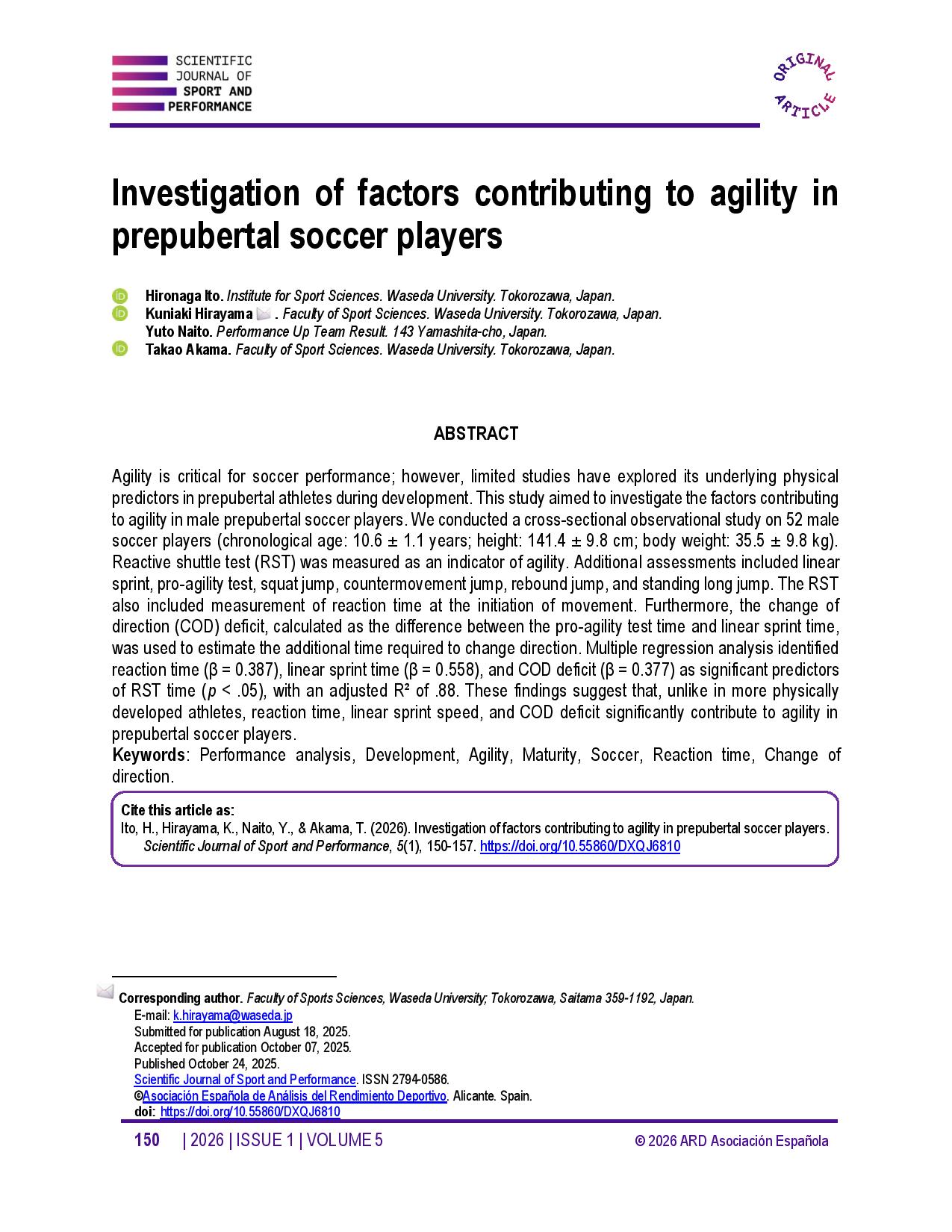Investigation of factors contributing to agility in prepubertal soccer players
Main Article Content
Abstract
Agility is critical for soccer performance; however, limited studies have explored its underlying physical predictors in prepubertal athletes during development. This study aimed to investigate the factors contributing to agility in male prepubertal soccer players. We conducted a cross-sectional observational study on 52 male soccer players (chronological age: 10.6 ± 1.1 years; height: 141.4 ± 9.8 cm; body weight: 35.5 ± 9.8 kg). Reactive shuttle test (RST) was measured as an indicator of agility. Additional assessments included linear sprint, pro-agility test, squat jump, countermovement jump, rebound jump, and standing long jump. The RST also included measurement of reaction time at the initiation of movement. Furthermore, the change of direction (COD) deficit, calculated as the difference between the pro-agility test time and linear sprint time, was used to estimate the additional time required to change direction. Multiple regression analysis identified reaction time (β = 0.387), linear sprint time (β = 0.558), and COD deficit (β = 0.377) as significant predictors of RST time (p < .05), with an adjusted R² of .88. These findings suggest that, unlike in more physically developed athletes, reaction time, linear sprint speed, and COD deficit significantly contribute to agility in prepubertal soccer players.
Article Details

This work is licensed under a Creative Commons Attribution-NonCommercial-ShareAlike 4.0 International License.
References
Altmann, S., Neumann, R., Härtel, S., Kurz, G., Stein, T., & Woll, A. (2021). Agility testing in amateur soccer: A pilot study of selected physical and perceptual-cognitive contributions. PLoS One, 16(6), e0253819. https://doi.org/10.1371/journal.pone.0253819 DOI: https://doi.org/10.1371/journal.pone.0253819
Andrašić, S., Gušić, M., Stanković, M., Mačak, D., Bradić, A. Sporiš, G., & Trajković, N. (2021). Speed, change of direction speed and reactive agility in adolescent soccer players: Age related differences. Int J Environ Res Public Health, 18(11), 5883. https://doi.org/10.3390/ijerph18115883 DOI: https://doi.org/10.3390/ijerph18115883
Bloomfield, J., Polman, R., & O'Donoghue, P. (2007). Physical demands of different positions in FA Premier League soccer. J Sports Sci Med, 6(1), 63-70.
Dos'Santos, T., McBurnie, A., Comfort, P., & Jones, P. A. (2019). The effects of six-weeks change of direction speed and technique modification training on cutting performance and movement quality in male youth soccer players. Sports (Basel), 7(9), 205. https://doi.org/10.3390/sports7090205 DOI: https://doi.org/10.3390/sports7090205
Fiorilli, G., Mitrotasios, M., Iuliano, E., Pistone, E.M., Aquino, G., Calcagno, G., & DI Cagno, A. (2017). Agility and change of direction in soccer: Differences according to the player ages. J Sports Med Phys Fitness, 57(12), 1597-1604. https://doi.org/10.23736/S0022-4707.16.06562-2 DOI: https://doi.org/10.23736/S0022-4707.16.06562-2
Hirose, N., Hirano, A., & Fukubayashi, T. (2002). Cross-sectional change in reaction time and stepping ability estimated from skeletal and chronological age in adolescent soccer players. J Phys Fit Sports Med, 51, 299-306. (in Japanese). https://doi.org/10.7600/jspfsm1949.51.299 DOI: https://doi.org/10.7600/jspfsm1949.51.299
Ito, H., Hirayama, K., Naito, Y., N., & Akama, T. (2025). Does reactive shuttle test differentiate performance levels in youth soccer players? J. Phys. Educ. Sport, 25, 363-369. https://doi.org/10.7752/jpes.2025.02041 DOI: https://doi.org/10.7752/jpes.2025.02041
Jimenez-Olmedo, J. M., Pueo, B., Mossi, J. M., & Villalon-Gasch, L. (2023). Concurrent validity of the inertial measurement unit Vmaxpro in vertical jump estimation. Appl Sci, 13(2), 959. https://doi.org/10.3390/app13020959 DOI: https://doi.org/10.3390/app13020959
Kameda, M., Mizutani, M., Sugiyama, T., Kiba, K., & Maeda, A. (2019). Influence of the side step under unpredictable conditions on lower limb and trunk kinematics of lateral cutting maneuvers in basketball players. Jpn J Phys Educ Health Sport Sci, 64, 705-717. (in Japanese). https://doi.org/10.5432/jjpehss.19003 DOI: https://doi.org/10.5432/jjpehss.19003
Mornieux, G., Gehring, D., Fürst, P., & Gollhofer, A. (2014). Anticipatory postural adjustments during cutting manoeuvers in football and their consequences for knee injury risk. J Sports Sci, 32(13), 1255-1262. https://doi.org/10.1080/02640414.2013.876508 DOI: https://doi.org/10.1080/02640414.2013.876508
Niering, M., Heckmann, J., Seifert, J., Ueding, E., von Elling, L., Bruns, A., & Beurskens, R. (2025). Effects of combined plyometric and sprint training on sprint performance in youth soccer players. Physiologia, 5(1), 5. https://doi.org/10.3390/physiologia5010005 DOI: https://doi.org/10.3390/physiologia5010005
Papaiakovou, G., Giannakos, A., Michailidis, C., Patikas, D., Bassa, E., Kalopisis, V., Anthrakidis, N., & Kotzamanidis, C. (2009). The effect of chronological age and gender on the development of sprint performance during childhood and puberty. J Strength Cond Res, 23(9), 2568-2573. https://doi.org/10.1519/JSC.0b013e3181c0d8ec DOI: https://doi.org/10.1519/JSC.0b013e3181c0d8ec
Paprancova, A., Paska, L., Krümar, M., Czakova, N., & Novotka, F. (2024). Factors influencing reactive agility in male football players. J Phys Educ Sport, 24(9), 1171-1176. https://doi.org/10.7752/jpes.2024.09241 DOI: https://doi.org/10.7752/jpes.2024.09241
Sheppard, J. M., & Young, W. B. (2006). Agility literature review: Classifications, training and testing. J Sports Sci, 24(9), 919-932. https://doi.org/10.1080/02640410500457109 DOI: https://doi.org/10.1080/02640410500457109
Stojanović, E., Aksović, N., Stojiljković, N., Stanković, R., Scanlan, A. T., & Milanović, Z. (2019). Reliability, usefulness, and factorial validity of change-of-direction speed tests in adolescent basketball players. J Strength Cond Res, 33(11), 3162-3173. https://doi.org/10.1519/JSC.0000000000002666 DOI: https://doi.org/10.1519/JSC.0000000000002666
Tauchi, K., Endo, T., Ogata, M., Matsuo, A., & Iso, S. (2008). The characteristics of jump ability in elite adolescent athletes and healthy males: The development of countermovement and rebound jump ability. Int J Sport Health Sci, 6, 78-84. https://doi.org/10.5432/ijshs.6.78 DOI: https://doi.org/10.5432/ijshs.6.78
Trajković, N., Sporiš, G., Krističević, T., Madić, D. M., & Bogataj, Š. (2020). The importance of reactive agility tests in differentiating adolescent soccer players. Int J Environ Res Public Health, 17(11), 3839. https://doi.org/10.3390/ijerph17113839 DOI: https://doi.org/10.3390/ijerph17113839
Veršić, S., Foretić, N., Spasić, M., & Uljević, O. (2020). Predictors of agility in youth soccer players: Contextualizing the influence of biological maturity. Kinesiol Slov, 26(3), 31-47. https://doi.org/10.52165/kinsi.26.3.31-47 DOI: https://doi.org/10.52165/kinsi.26.3.31-47
Young, W. B., Dawson, B., & Henry, G. J. (2015). Agility and change-of-direction speed are independent skills: Implications for training for agility in invasion sports. Int J Sports Sci Coach, 10(1), 159-169. https://doi.org/10.1260/1747-9541.10.1.159 DOI: https://doi.org/10.1260/1747-9541.10.1.159




